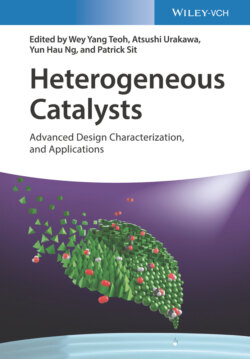Читать книгу Heterogeneous Catalysts - Группа авторов - Страница 37
3.2.2.1 Pulse Electrodeposition
ОглавлениеBesides the conventional direct current (DC) electrodeposition as discussed above, pulse current (PC) and pulse reverse current (PRC) methods are other modes of electrodeposition that are found useful in yielding nanostructured thin films with enhanced features. Figure 3.5 depicts the modulation of pulse condition in conventional direct current electrodeposition (non‐pulse), PC, and PRC electrodeposition methods. Empowered by modern electronics and microprocessor, applied current waveform can be conveniently introduced. PC and PRC are among the most typical waveforms generated. In PC, cathodic pulse is followed by a period of time without current, while cathodic pulses followed by anodic pulses are defined as PRC. In terms of advantages in the resultant deposits, in brief, PC method affords a more compact deposit with fewer defects of pores or cracks, while PRC method can decrease internal stresses of the deposits. The technical details and advantages PC and PRC over direct current and the relationships of the deposit properties to the pulsing parameters such as frequency and current distribution have been reported previously [28]. Example of catalytic thin films made by pulse technique includes a low loading and evenly distributed Pt–Co cathode catalyst on a Nafion‐bound carbon layer [29]. The pulse‐deposited Pt–Co catalysts are homogeneously coated on the carbon electrode at a thickness of around 6 μm, four times thinner than conventional Pt–C, and were found to improve proton‐exchange membrane fuel cell (PEMFC) performance. Another noticeable feature of pulse electrodeposition is its ability to yield a conformal coating on nanostructured substrate. The emerging use of 1D nanotube or nanorod thin film has introduced new challenge in the coating of such an uneven surface at microscopic scale. Conventional direct current method always results in a solid layer electrodeposited on top of the nanotubular layer without penetration into the bottom region of the nanotubes. The limitation in conformal coating by normal direct current is due to the rapid reduction of the metallic cations at the surface (or entrance) of the nanotube/nanorod arrays. The resultant deposit formed initially on the top region continues to grow and eventually blocks the subsequent reduction of cations. Introduction of PC in the deposition involving nanotube/nanorods overcomes this weakness. During cathodic pulse, metallic cations are reduced on the surface of nanotubular substrate, while the following zero‐current pulse allows the relaxation of the deposition that allows the fresh precursor to diffuse into the deeper region of such nanostructure for the subsequent cathodic pulse. The repeating deposition and relaxation cycles eventually allow the entire surface of nanotube/nanorod to be deposited by the target metals from the top to the bottom region [30–32]. Conformal coating of nanostructured catalytic thin film is a critical aspect. When the catalytic active material is not stable in the reaction medium (e.g. the catalyst will go through chemical or photo‐dissolution during reaction), the conformal coating helps to suppress or avoid this deactivation challenge by providing a conformal protective layer. Cuprous oxide and zinc oxide are examples of unstable catalytic materials. Pulse electrodeposition of protective layers on the nanostructures of cuprous oxide and zinc oxide has been found useful in extending their usable lifetime.
Figure 3.5 Different modes of current density for electrodeposition (a) direct current (DC), (b) pulse current (PC), and (c) pulse reverse current (PRC).
